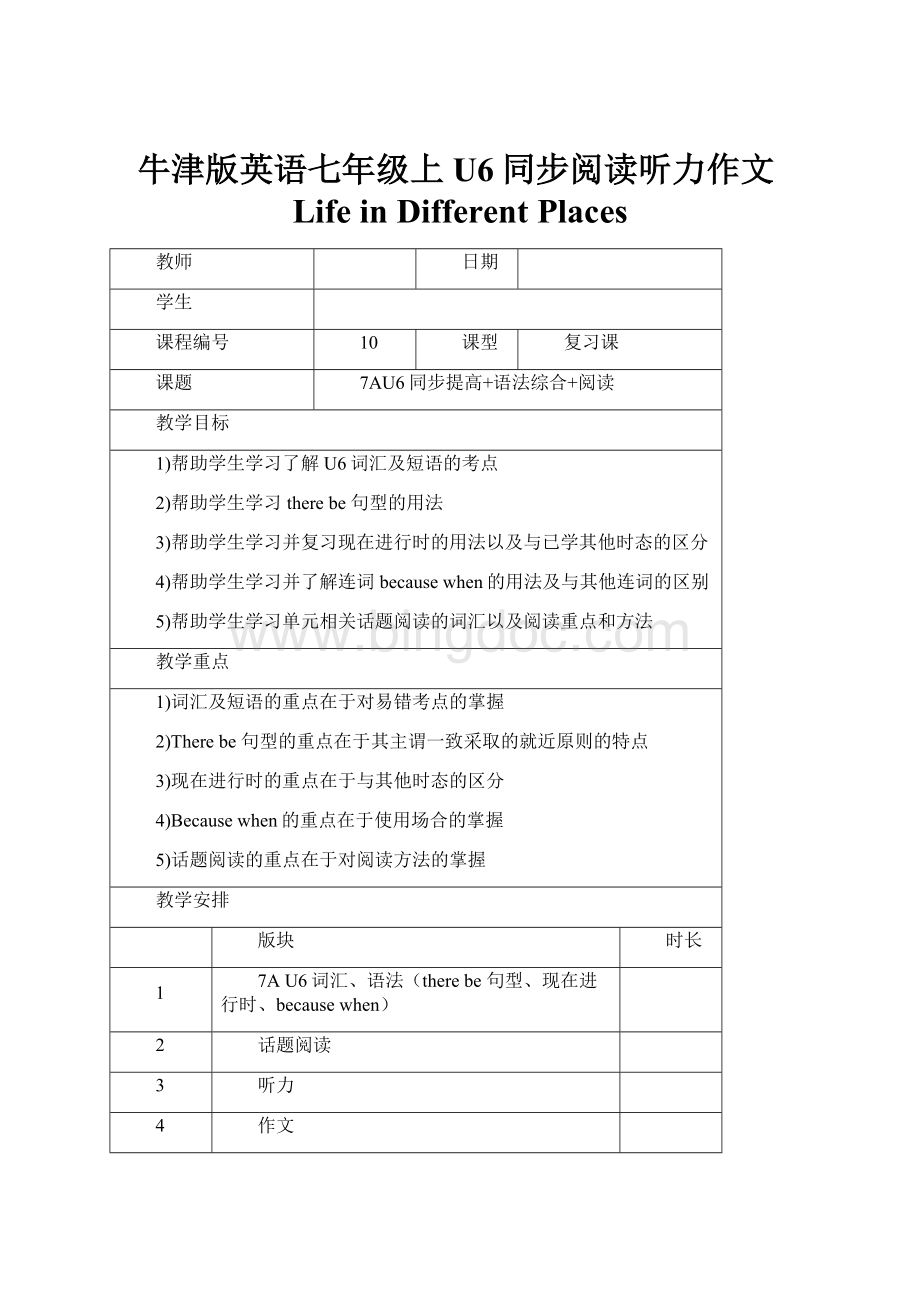牛津版英语七年级上U6同步阅读听力作文Life in Different Places.docx
《牛津版英语七年级上U6同步阅读听力作文Life in Different Places.docx》由会员分享,可在线阅读,更多相关《牛津版英语七年级上U6同步阅读听力作文Life in Different Places.docx(26页珍藏版)》请在冰点文库上搜索。

牛津版英语七年级上U6同步阅读听力作文LifeinDifferentPlaces
教师
日期
学生
课程编号
10
课型
复习课
课题
7AU6同步提高+语法综合+阅读
教学目标
1)帮助学生学习了解U6词汇及短语的考点
2)帮助学生学习therebe句型的用法
3)帮助学生学习并复习现在进行时的用法以及与已学其他时态的区分
4)帮助学生学习并了解连词becausewhen的用法及与其他连词的区别
5)帮助学生学习单元相关话题阅读的词汇以及阅读重点和方法
教学重点
1)词汇及短语的重点在于对易错考点的掌握
2)Therebe句型的重点在于其主谓一致采取的就近原则的特点
3)现在进行时的重点在于与其他时态的区分
4)Becausewhen的重点在于使用场合的掌握
5)话题阅读的重点在于对阅读方法的掌握
教学安排
版块
时长
1
7AU6词汇、语法(therebe句型、现在进行时、becausewhen)
2
话题阅读
3
听力
4
作文
5
师生总结
6
作业布置
Part1课文Review
Lucy:
WhereDoYouLive?
Youliveonthisstreet?
David:
Yeah.
Lucy:
Youhaven’tmovedyet?
Ithoughtyou'vetoldme,youwanttom_____1_____out.
David:
IwantedtomoveandIstillwanttomove.MaybenextmonthIwillmove.Ialwayssaynextmonth,nextmonth,nextmonth.IthasalreadybeenmanymonthsandIkeepsayingnextmonth.
Lucy:
Soyoupayrent(租金)everymonth,noteveryseason,right?
David:
Everymonth.MaybeIshouldmovetoyourn_____2_____.IsitniceinShangdi?
Lucy:
ThetraffictoShangdiusedtobebad,butnowtheyhaveconstructed(建造)anotherbetterwaytothearea.
David:
Howisitbetter?
Lucy:
Theroadisbetterandmorec_____3_____.Thelocation(位置)isverypopular.Infact,IthinkMr.BaolivedinShangdibefore,butmaybehehasalreadymoved.
David:
Oh,really.Therearesomenewf_____4_____inthewestsideofthecity.Manypeoplehavemovedthererecently.Maybehehasaswell.
Part2根据音标写单词
序号
英文
音标
词性
中文
1
['piːsfl]
adj.
平静的
2
[kən'viːniənt]
adj.
方便的
3
['bɒtəm]
n.
底部
4
[stiːp]
adj.
陡的
5
[step]
n.
台阶
6
['nɔɪzi]
adj.
吵闹的
7
[ɪk'saɪtɪŋ]
adj.
令人激动的
8
['pleznt]
adj.
令人愉快的
9
[rɪ'læksɪŋ]
adj.
令人放松的
10
[faɪ'nænʃl]
adj.
金融的
11
[tʃɜːtʃ]
n.
教堂
12
['stætʃuː]
n.
雕塑
13
['faʊntən]
n.
喷泉
14
['stɔːribʊk]
n.
童话书
15
[ɡlʌv]
n.
手套
Part3词汇语法复习
(1)7AU6词性转换整理
1
adj.
平静的
adv.
平静地
n.
和平
2
adj.
方便的
n.
方便
3
n.
街区,城区
n.
邻居
4
adj.
吵闹的,嘈杂的
n.
噪声
adv.
喧闹地
5
adj.
令人激动的,使人兴奋的
adj.
感到激动的,感到兴奋的
6
adj.
令人愉快的
n.
愉快,高兴
adj.
高兴的,乐意的
7
adj.
令人放松的
adj.
放松的,随意的
v.
(使)放松
8
adj.
金融的,财政的
n.
金融,财政
I.Choosethebestanswer:
(选择最恰当的答案)
1.It’simportant______us______domorningexerciseseveryday.
A.of;toB.for;toC.in;toD.to;for
2.Ben'sbedroomhasenoughspace______allhisthings.
A.toB.aboutC.forD.of
3.—Is______intherightplace,Tom?
—Yes,everythingisinitsplace.
A.everythingB.somethingC.anythingD.nothing
4.Thenewflathas______roomsthantheoldone.
A.muchB.moreC.manyD.moremuch
5.Whatarethedifferences______thetworooms?
A.amongB.inC.betweenD.with
6Thankstotheirnewinventions,ourlivesaremuch______thanbefore.
A.convenientB.moreconvenient
C.mostconvenientD.themostconvenient
7.Inhisletter,UncleLeetoldusmany______abouthisvisittotheUnitedStates.
A.newsB.storiesC.informationD.truth
8Wehaven'theardfromthem______lastmonth.
A.sinceB.bytheendofC.forD.until
9.There______apairofsportsshoesunderthebed.
A.isB.areC.hasD.have
10.Iwanttoknowiftheyare______.
A.GermansB.GermenC.GermanyD.German
II.Completethesentenceswiththegivenwordsintheirproperforms(用括号中所给单词的适当形式完成下列句子):
(共8分)
1.Lawandorder(秩序)arenecessaryfora__________society.(peace)
2.It'sagreat__________toliveintown.(convenient)
3.Thereisnosuchmaninour__________.(neighbor)
4.Ipreferthequietcountrysidetothe__________cities.(noise)
5.Thatwasthemost__________filmoftheyear.(excite)
6.Wespentmanyhoursina__________conversation.(please)
7.AssoonasIhadmadethefinaldecision,Ifeltalotmore__________(relax)
8.AndIgotthe__________supportaftertwoyears.(finance)
III.Rewritethefollowingsentencesasrequired(根据所给要求,改写下列句子,每空格限填一词):
(共12分)
1.ThenewflatcostMr.Blackalotofmoney.(改为否定句)
Thenewflat__________costMr.Black__________money.
2.Lilyhadagoodtimewithherfriendsattheparty.(改为一般疑问句)
__________Lily__________agoodtimewithherfriendsattheparty?
3.I’vereallyenjoyedswimminginwintersinceIwastwenty.(对划线部分提问)
____________________haveyoureallyenjoyedswimminginwinter?
4.Kateisneverabsentfromschool.(改为反意疑问句)
Kateisneverabsentfromschool,____________________?
5.Wehavefineweathertoday.(改为感叹句)
____________________weatherwehavetoday!
6.Iamnotabletorunthe100-meterracewithin14seconds.(保持句意基本不变)
__________isimpossible__________metorunthe100-meterracewithin14seconds.
(2)7AU6语法复习
1.Therebe句型
2.现在进行时
3.because/when
☆Therebe句型
I.Therebe句型的基本用法是表示“某地(或某时)有某人(或某物)”,
。
这里there是引导词,没有词义,be是谓语动词,代词或名词(短语)是主语。
例如:
1.______________adeskandtwochairsintheroom.有一张桌子和两把椅子在房间里。
2.______________twochairsandadeskintheroom.有两把椅子和一张桌子在房间里。
2.______________twochairsandadeskintheroom.(否定句)
3.______________anythingwrongwithyourears?
(Yes,thereis./No,thereisn't.)
4.Therewasn'tameetingyesterday,_______________?
(反意疑问句)
II.除此之外,还有一个重要句式,要用“例如:
_______________severalchildren________intheriver.河里有几个孩子在游泳。
III.Therebe结构中各种时态的变化是通过的变化来体现的。
IV.Therebe句型表示“存在”关系,have表示“所属”关系,两者不能混合在一个句子中。
例如,要说“明天有一个班会。
”
(1)Therewillhaveaclassmeetingtomorrow.(×)
V.复习Therebe句型时除了掌握基础知识外,还应注意以下问题:
1.Therebe句型的考查更多的是将be动词与主语结合在一起进行的,即主谓的一致性。
例如:
(1)Thereis_____onthefloor.
(2)Thereare_____onthefloor.
A.catB.waterC.boxesD.football
2.如果作主语的是一个短语,则常常考查短语中的修饰语。
可数名词的复数形式前可以用any,some,few,afew,many或用数词+hundred/thousand/million,hundreds/thousands/millionsof,no等修饰;不可数名词可以受any,some,no,little,alittle,much等词的修饰。
例如:
(1)Therewere_____studentsinourschool.
A.hundredsB.eighthundredC.eighthundredsof
(2)Thereis_____water.Youneedn'tgetsomemore.
A.fewB.littleC.much
3.注意不定代词的用法。
(1)
例如:
_______________nothinginthefridge.
(2)不定代词受形容词修饰时要放在形容词的前面。
例如:
Thereissomethinginterestingintoday'snewspaper.
如果陈述部分含有little,few,no,nobody,none等否定词时,后面的简短问句中要用肯定形式。
例如:
Thereisnobodyintheroom,isthere?
但有的含有否定意义的形容词修饰不定代词时则仍看作肯定句式。
例如:
Thereissomethingunusualintheroom,isn'tthere?
☆现在进行时
I.现在进行时的构成
现在进行时由"be+v-ing"构成。
be应为助动词,初学者最容易漏掉,它应与主语的人称和数保持一致。
II.现在进行时
在实际运用时,现在进行时常用以下几种情况:
(1)当句子中有now时,常表示动作正在进行,这时要用现在进行时。
如:
They_________________________now.现在他们正在打篮球。
(2)以look,listen开头的句子,提示我们动作正进行,这时要用现在进行时。
如:
Listen!
She________________anEnglishsong.听,她正在唱英语歌。
(3)表示当前一段时间或现阶段正在进行的动作,且此时有thisweek,thesedays等时间状语,这时常用现在进行时。
如:
We______________modelplanesthesedays.这些天我们在做飞机模型。
(4)描述图片中的人物的动作,也为了表达更生动。
此时也常用现在进行时。
如:
Lookatthepicture.Thechildren_____________________inthepark.看这幅图,那些孩子正在公园放风筝。
III.现在进行时的句型变化
肯定句式:
主语+be(am,is,are)+现在分词+其它.
否定句式:
主语+be(am,is,are)+not+现在分词+其它.
一般疑问句:
Be(Am,Is,Are)+主语+现在分词+其它?
特殊疑问句:
疑问词+be(am,is,are)+主语+现在分词+其它?
对现在进行时的特殊疑问句的回答,它不可以用Yes或No直接作答,要根据实际情况回答。
IV.并不是所有动词都有进行时,一些动词一般在句中不能用现在进行时态,而应用一般现在时。
这些动词往往是等表示情感状态、知觉认识、愿望或短暂性的动词。
例如:
see(明白),know,want,like,hear,have(有),think,hope,hate等。
☆because,when
这三个连词都可引导时间状语从句,但用法有所不同。
1当某事正在进行的时候,又发生了另一件事。
while,when,as都可用来引导表示“背景”的时间状语从句。
例如:
As/When/WhileIwaswalkingdownthestreetInoticedapolicecar.
2当两个长动作同时进行的时候,最常用的是while。
例如:
_______motherwascookinglunch,Iwasdoingmyhomework.
3当两个动作都表示发展变化的情况时,最常用的是as。
例如:
_______childrengetolder,theybecomemoreandmoreinterestedinthingsaroundthem.
4当两个短动作同时发生时,或表示“一边…一边…”时,最常用as。
例如:
Just_______hecaughtthefly,hegavealoudcry.
Shelookedbehindfromtimetotime_______shewent
5当从句的动作先于主句的动作时,通常用when。
例如:
________hefinishedhiswork,hetookashortrest.
6当从句是瞬间动作,主句是延续性动作时,通常用when。
例如:
_______JohnarrivedIwascookinglunch.
这四个词都可表原因,但用法有区别。
1如果原因构成句子的最主要部分,一般用because。
因此,because引导的从句往往放在句末。
例如:
Istayedathome________itrained.
---Whyaren’tyougoing?
---_________Idon’twantto.
2如果原因已被人们所知,或不如句子的其它部分重要,就用as或since。
Since比as稍微正式一点。
As和since引导的从句一般放在句子的开头。
例如:
________hewasn’tready,weleftwithouthim.
________Ihavenomoney,Ican’tbuyanyfood.
3for用来补充说明一种理由,因此,for引导的从句几乎可以放在括号里。
For引导的句子不放在句子的开头。
例如:
Idecidedtostopandhavelunch_______Iwasfeelingquitehungry.
.Choosethebestanswer.(选择最恰当的答案)
1.Therewillbeavolleyballmatchinourschool,______?
A.bethereB.isthereC.willthereD.won'tthere
2.Thereweretwo______peopleatyesterday'smeeting.
A.hundredsB.hundredsofC.hundredD.hundredof
3.Thereisgoingto______areport______Chinesehistoryinourschoolthisevening.
A.have;onB.be;onC.have;forD.be;of
4.Thereis______intoday'snewspaper.
A.nothingnewB.anythingnewC.newanythingD.newsomething
5.Therearefew______inthefridge.Let'sgoandbuysomepeas,carrotsandcabbages.
A.vegetablesB.fruitC.meatD.eggs
6.He______hisfatheronthefarmthewholeafternoonlastSaturday.
A.helpsB.wouldhelpC.washelpingD.ishelping
7.I______amealwhenyou______me.
A.cooked,wereringingB.wascooking,rang
C.wascooking,wereringing D.cooked,rang
8.Hesaidhe______todrawaplaneontheblackboardatthattime.
A.triesB.triedC.wastryingD.willtry
9.Whileshe______TV,she______asoundoutsidetheroom.
A.waswatching,washearingB.watched,washearing
C.watched,heardD.waswatching,heard
10.They_